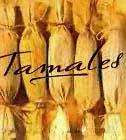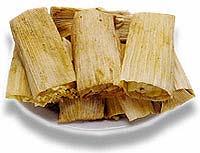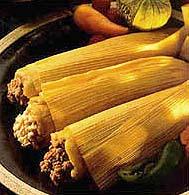Mexican Kitchen

Mexico is the land of fiestas, and never more than during the month of December, when the feasts are so many that they overlap by several days. Starting on December 3, the beginning of the nine-day tribute to the Virgin of Guadalupe, and continuing through until January 6, Three Kings Day, there is non-stop celebration. In addition to Guadalupe’s feast day on December 12, the Mexicans honor the Virgin of Juquila on the 8th and Nuestra Señora de Soledad on the 18th. Besides Christmas itself there are the posadas, Christmas parties which run from December 16 through 24. And let’s not forget the nine days of Hannukah, celebrated by Mexico’s Jewish community, or the Night of the Radishes, a great Oaxacan fiesta held on the 23rd.
The one food that is served at just about every fiesta is the tamal, and las fiestas diciembrinas, the December feasts, are no exception. I have never been to a posada that does not feature at least two kinds of tamales along with ponche navideña and the traditional bueñuelo fritters. Nancy Helman Sneiderman, writing of a Chanukah visit to a beachfront synagogue in Veracruz, tells us that “the feast consisted of tamales, cake, pasta, beans and rice.” On the morning of the feast of the Virgin of Guadalupe, following the all-night bonfires, many of the churches in Cholula distribute tamales to all the mothers with the singing of Las Mañanitas to the Virgin; I remember several happy years living in that town and carrying home my tamales on December 12 and on Mother’s Day.
One wonders why, since they are commonly eaten on an everyday basis, tamales are an essential feast day food, and the answer lies in the sense of ritual that has been part of Mexican life since pre-Hispanic times. Each important celebration, whether a rite of passage through life or a feast honoring one of the gods, had its own distinct type of tamal filling and form, including those decorated with designs of seeds and beans. Tamales of various shapes and flavors were prepared by nearly all the groups of original inhabitants of Mexico.

Spanish priest and chronicler Bernardino de Sahagun observed that the first thing Aztec women did when preparing a festival was to make lots of tamales: tamales with amaranth leaves for the fire god Xiuhtecuhtli, tamales with beans and chiles for the jaguar god Tezcatlipoca, shrimp and chile sauce tamales for the ancient deity Huehueteotl. Besides tamales stuffed with turkey meat, beans and chiles, the Aztecs used what they harvested from the shores of Lake Texcoco, including fish and frogs, to fill tamales. Sahagun tells us that pocket-gopher tamales were “always tasty, savory, of very pleasing odor.” Etiquette dictated that tamales, which were passed around in a basket at banquets, were held in the left hand.
The Maya also produced artistic, elaborate tamales, some rolled out and filled jelly-roll fashion, cut to show the spiral designs thus produced, which can be seen in the banquet scenes depicted on Classic Maya vases. The spinach-like herb called chaya, still very much used in the Mayan regions of Mexico, was one of their alternatives to using corn husks and banana leaves as tamal wrappers. Toasted squash seeds and flowers, meat, fish, fowl, and beans were all used as fillings. Deer meat, especially the heart, was favored for special offerings. Besides being steamed, tamales were roasted on the comal or baked in the pib, or pit oven.

The great variety of tamales has carried over to this day; ethnographers have counted forty two different kinds, including the famous zacahuil prepared by the Huastecan people. This tamal is 3 feet long, weighs about 150 pounds, and requires most of the leaves of a banana tree to wrap it. The zacahuil and the muchipollo of the Yucatan are exceptions to the tamal-making rule in that they are baked either in the ground or in a bread oven rather than being steamed. Other unique tamales are the pastel-colored versions prepared by the Otomi people near San Miguel de Allende and the fresh fish clapiques of the coast, which have been prepared since the time of Moctezuma II.
Although the first tamales were simply made with ground maize and flavored with oils extracted from avocado and sesame plants, the arrival of the Spaniards, and with them various domestic animals including the pig, changed the consistency of tamales forever. Lard is essential to the texture of what we know as tamales today, although vegetable shortening may be used in its place. In either case, the dough is much lighter than that of the pre-Conquest era.
Music, too, is an important ingredient, since Mexican cooks claim that tamales will not turn out light and fluffy unless music is played while they are being made. When we first moved to Cholula, we wondered why the next door neighbor began blasting music in the wee hours on Saturday and Sunday mornings, until we found out that she was a weekend tamal vendor and needed the musical accompaniment.
Whether you choose a sweeping symphony, a rousing march , or good old rock and roll to inspire your tamal-making, it’s more fun with friends. Make lots, because tamales freeze well and can be reheated on a grill or griddle, in the oven, or in a microwave. You might try more than one of the recipes below if the music really gets you going, but in any case, making tamales is almost as much fun as the fiesta itself.
Recipes:
- Tamales: Basic Tamales
- Tamales Rojos Veracruzanos con Pollo: Veracruz-Style Tamales with Chicken
- Tamales Dulces: Sweet Tamales
